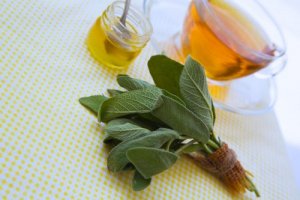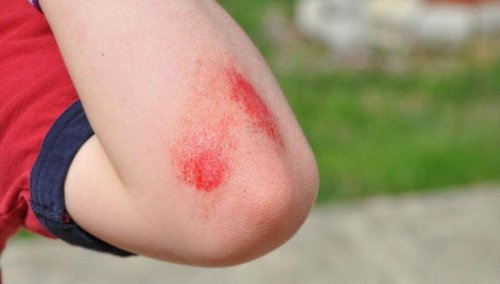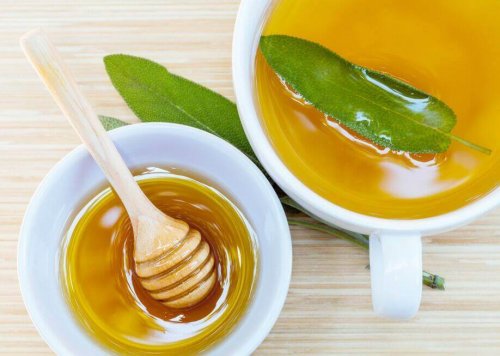Sage and Honey to Treat Cuts and Scrapes

There are several methods to treat cuts and scrapes, depending on how serious they are. Many times, the wound heals on its own if it’s superficial and the skin is kept clean. However, you can also try some natural remedies to accelerate the process.
Some natural ingredients, such as sage and honey, have antiseptic and antimicrobial properties that help protect the skin from infection. Furthermore, both contain antioxidants and essential nutrients that aid healing.
Discover how to use them below!
Sage and honey to treat cuts and scrapes
Cuts and scrapes occur when one of the areas of the skin suffers damage. These often cause bleeding, redness, and pain. They can become infected and cause other symptoms such as pus and swelling. However, if treated properly, the healing process is fast and doesn’t usually cause complications.
Fortunately, nowadays, many treatment options protect the skin when these superficial wounds occur. While many options are pharmaceutical, some natural preparations can be very useful.
This is the case of the sage and honey home remedy we’ll share here. Both of its ingredients are known for its antiseptic and healing properties. This combination is the perfect alternative to disinfect affected skin, minimizing the risk of infection. It also helps soothe irritation and relieve the swelling that occurs around the wound.

This sage and honey preparation is a natural antiseptic to treat superficial cuts and scrapes.
The benefits of sage to treat cuts and scrapes
Sage is one of the medicinal plants that can help treat cuts and scrapes thanks to its antiseptic and antimicrobial properties. It’s been used in natural medicine since ancient times due to its ability to prevent the growth of bacteria and other pathogenic microorganisms.
When used externally, it not only reduces the risk of infection in the exposed areas, but also helps regenerate tissues for optimal healing.
Discover: 6 Healing Properties of Sage
The benefits of honey to treat cuts and scrapes
Organic honey is one of the most popular alternative remedies to treat cuts and scrapes. Due to its antibiotic, antifungal, and antiseptic properties, it’s an excellent option to prevent and treat infections.
On the other hand, using it topically benefits skin health, as it’s moisturizing and helps regenerate the tissues that were damaged due to a wound. In fact, it’s soothing and relieves discomfort such as burning, itching, and pain.
How to make the sage and honey preparation

Due to its antibiotic and antimicrobial properties, this home remedy can prevent the infection of minor injuries. It also moisturizes and heals.
This natural remedy to treat cuts and scrapes is quite easy to make. Also, the ingredients are readily available in most supermarkets and herbal shops. The most important thing is to make sure you buy 100% organic honey, as other varieties don’t have the same nutritional quality and properties.
Ingredients
- 2 tablespoons of dried sage powder (30 g)
- 4 tablespoons of organic honey (60 g)
Supplies
- A sterile jar
- A wooden spoon
Read on: 8 Benefits of Eating Honey Daily
Preparation
- First, grind several dried sage leaves to a fine powder. If you prefer, buy powdered sage extract at an herbal shop.
- Then, pour the sage powder in a previously sterilized jar.
- After that, add the tablespoons of honey and mix using a wooden spoon.
- When the preparation is ready, cover it and leave it in a cool, dark place for 24 hours.
- After this time, you can start using it.
How to apply
- Thoroughly clean the wound and then apply the sage and honey remedy.
- Gently massage and leave on for 20 to 30 minutes.
- Then, rinse with warm water.
- Apply this preparation two to three times a day until your skin is completely healed.
Caution: Avoid using this remedy on open cuts or scrapes. Please note that serious injuries should be treated by a professional as soon as possible. Thus, if your wound looks severe, go see a doctor immediately.
Is this remedy part of your first aid kit? Now that you know how to make it, make sure to keep it handy in case of minor wounds. This preparation can last one or two months if stored in the refrigerator or a cool place.
All cited sources were thoroughly reviewed by our team to ensure their quality, reliability, currency, and validity. The bibliography of this article was considered reliable and of academic or scientific accuracy.
- Karimzadeh, S., & Farahpour, M. R. (2017). Topical application of Salvia officinalis hydroethanolic leaf extract improves wound healing process. Indian Journal of Experimental Biology, 55(2), 98–106.
- McLoone P, Oluwadun A, Warnock M, Fyfe L. Honey: A Therapeutic Agent for Disorders of the Skin. Cent Asian J Glob Health. 2016;5(1):241. Published 2016 Aug 4. doi:10.5195/cajgh.2016.241
- Yaghoobi R, Kazerouni A, Kazerouni O. Evidence for Clinical Use of Honey in Wound Healing as an Anti-bacterial, Anti-inflammatory Anti-oxidant and Anti-viral Agent: A Review. Jundishapur J Nat Pharm Prod. 2013;8(3):100–104.
- Minden-Birkenmaier BA, Bowlin GL. Honey-Based Templates in Wound Healing and Tissue Engineering. Bioengineering (Basel). 2018;5(2):46. Published 2018 Jun 14. doi:10.3390/bioengineering5020046
- Lordani TVA, de Lara CE, Ferreira FBP, et al. Therapeutic Effects of Medicinal Plants on Cutaneous Wound Healing in Humans: A Systematic Review. Mediators Inflamm. 2018;2018:7354250. Published 2018 Apr 1. doi:10.1155/2018/7354250
This text is provided for informational purposes only and does not replace consultation with a professional. If in doubt, consult your specialist.








